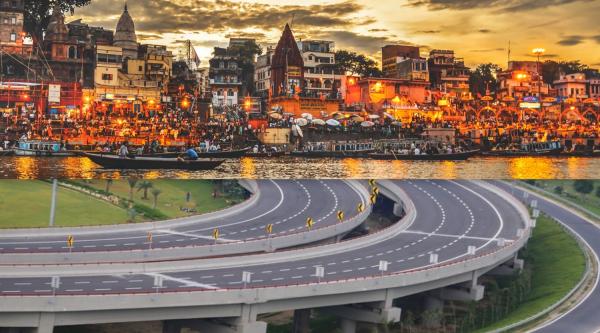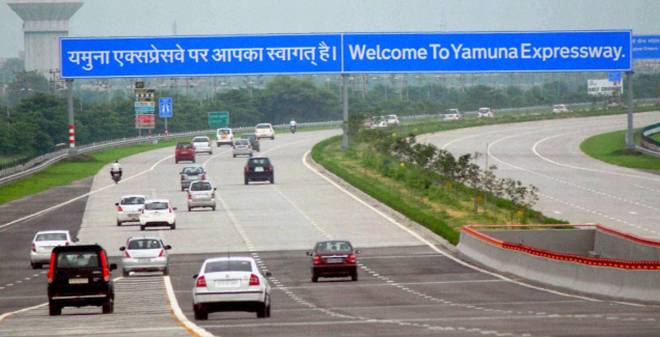
Uttar Pradesh is the fourth largest and most populous state in Bharat. It represents the core image of the country and is rightly called as the ‘Hindi-heartland’ not just because of its sheer size and population but also because of the religious, political and commercial importance of this state. On most of the development parameters, Uttar Pradesh finds itself standing last in Bharat. But for the last few years Uttar Pradesh has taken the path of economic development and this path passes through the High Speed Expressways.
Land of Sacred Cities
Uttar Pradesh has been central to the progression of many Dharmic Traditions, but it has a unique association with the Hindu religion. The river Ganga which is the heartbeat of Hindu religion traverses the length of this state. The cities located on the banks of Ganga are some of the most sacred Tirthsthals of Hindu religion and are of vital cultural and religious importance.
As per the ancient Hindu scriptures or Vedas, Hinduism has seven holy cities or Sapta Puri which includes Ayodhya, Mathura, Haridwar, Varanasi, Ujjain, Dwaraka and Kanchipuram. Of these seven, the three sacred cities of Ayodhya, Mathura and Varanasi are located in Uttar Pradesh.
Varanasi also known as Kashi, is an important tirthsthal for Hindus and is known as the City of Moksha. Archaeological evidences shows that Varanasi is world’s oldest continuously populated city.
Prayag (Allahabad) is the Sangam of the rivers Ganga, Yamuna, and Saraswati. The biggest congregation of humankind, The Kumbha Mela is held at Allahabad every 12th year. Millions of followers of Hindu religion as well as of other religion come from all over the world to visit this sacred city.
Mathura, also known as Brajbhoomi, is located on the banks of river Yamuna and is one the seven holiest cities of Hindu religion. Lord Krishna was born in Mathura and grew up in Vrindavan which is located nearby.
Who does not know Ayodhya? This is the birthplace of Maryada Purushottam Shri Ramchandra Ji. This town is situated in Awadh (in ancient times it was known as Kaushal) region of Uttar Pradesh.
The Modern Uttar Pradesh
The state of Uttar Pradesh, with its rich cultural heritage, has not been untouched by modernisation also. Calculations on the basis of the census report of 2011 show that today 45% of the state's population is under the age of 45, which emphasizes the requirement for job creation. The Agricultural and manufacturing production growth has provided employment opportunity to the rural as well as urban youth. As per the latest report by NSDP Uttar Pradesh makes up for 8% of the total GDP of India making it the 4th largest contributing state.
As per the Annual report on Agricultural production by the Ministry of India for Agriculture and Farmer welfare, with its extensive agricultural growth, the state accounts for 20% of the food grain produced in the country. The climatic and soil conditions are perfect for the cultivation of cash crops like sugarcane due to which, as per the agricultural report by USDA, 70% of the country’s sugar and its byproducts are produced in Uttar Pradesh.
Infrastructure growth

The Development trend is reflected in the extensive infrastructure development across the state.
In ancient times, the river Ganga and its tributaries were the most significant mode of travelling between major cities like Prayag, Lucknow, Varanasi etc. However, today the connectivity between these cities is completely revolutionised by the ongoing development of high-speed Expressways and Highways. Uttar Pradesh has the most extensive network of expressways in the country. Bharat has about 1,500 KM of Expressways and 40% of that is in Uttar Pradesh. Bharat’s longest Expressway measuring 512KM from NOIDA to Lucknow is also in UP. Though theoretically it is divided in two parts and Agra is the joining point. UP has more Expressways under construction or in planning phase than any other state.
Major Expressways
Yamuna Expressway – connects the near-capital region city of Greater Noida with Agra. It provides a high-speed path for people travelling from Delhi, the national capital, towards Agra where the famous Taj Mahal is located, is the most prominent tourist hub of the country. It also connects to Mathura via a link road before Agra.
Agra-Lucknow expressway – is one of the significant projects built in the state. This 302 km long high-speed Expressway between Agra and Lucknow goes through the cities like Kannauj, Unnao etc., boosting connectivity among cities of historical and economic significance.
Eastern Peripheral Expressway – also called National Expressway 2 (NE 2), makes a half circle around Delhi on eastern side. This 135 KM long Expressway starts at Kundli and ends at Palwal. Though both of these points are in Haryana but most of the Expressway goes through Uttar Pradesh.
Other than above-mentioned operational Expressways, UP has many more in various stages of planning and execution.
Conclusion
Infrastructure and road development is the foundation for the growth of every country. Construction of many modern Expressways in Uttar Pradesh, which is considered among most backward states of Bharat, is a sign of economic progress being made in the country. The most commendable part of this transformation is the importance being given to the sacred cities and culture while still moving forward on the path of modernisation.
Next time when you go on pilgrimage, experience the speed and comfort of modern Expressways!


